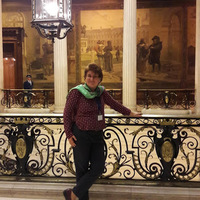
Melinda Mihály
Related Authors
Klára P. Kovács (Pakó)
Babes-Bolyai University
Rüsz-Fogarasi Enikő
Babes-Bolyai University
Weisz Attila
University of Art and Design, Cluj-Napoca, Romania
Kovács Zsolt
Babes-Bolyai University
Székely Zsolt
Babes-Bolyai University
Kovács András
Transylvanian Museum Society, Cluj-Napoca, Romania
Fejér Tamás
Transylvanian Museum Society, Cluj-Napoca, Romania









Uploads
Papers by Melinda Mihály
central square, later transforrned into a baroque noble palace, with rococo influences.
The Filstich-Kemeny house dates back to the late 15th-early 16111 century, later extended in
severa! stages of construction. One of the early stages probably included the construction of the upper
floor of the building, which coincided with the building of the doorframe with the engraved coat-of-anm,
the year 1597 and the monogram of Petru Filstich Jr (farnous goldsrnith, keeper ofthe Cluj's treasury and
councilor of prince Gabriel Bethlen). The quality of the work, the composition and the details make the
doorframe one of the most valuable renaissance frameworks in Cluj. The exquisite sculpture of the
doorframe and the fact that the most relevant personalities of the time were housed therein confirm the
fact that the Filstich house was one ofthe most pretentious buildings in the city's central square.
The plastic omaments of the main fai;ade were made in the last stage of the construction, and
their theme is unique in the whole art of Transylvania: the plaster bas-relief of Saint Florian, surrounded
by the representation ofthe four seasons ofthe year.
The study presents the structure and the inner layout of the building ever since the 17111 century,
as inferred from a partition document from 1672, as well as the line of landlords starting with the 16th
century all the way to the l 900s, in itself an accurate reconstitution of the tax registers preserved in the
State Archives, Department of Cluj.
temporary exhibition in the national History Museum of Transylvania, Cluj
The National History Museum o f Transylvania, Cluj (Cluj c., Romania) organised an exhibition focused on the presentation of the most wealthy period of the history if this town, mentioned by further documents as the era of the 'Treasure-Town". The opening day o f the
event was in 24 t h
June, 2004 and its curators were the History Department's specialists. The
exposition was organised with the co-operation of the Romanian Academy of Sciences and
the Protestant Churches the town. The exhibition presented the following themes: preliminaries (the privileges and the indigenous population of the town), the culture (the ecclesiastic colleges, the typographies, the Churches) and the economy (the guilds and fiscal
administration).
central square, later transforrned into a baroque noble palace, with rococo influences.
The Filstich-Kemeny house dates back to the late 15th-early 16111 century, later extended in
severa! stages of construction. One of the early stages probably included the construction of the upper
floor of the building, which coincided with the building of the doorframe with the engraved coat-of-anm,
the year 1597 and the monogram of Petru Filstich Jr (farnous goldsrnith, keeper ofthe Cluj's treasury and
councilor of prince Gabriel Bethlen). The quality of the work, the composition and the details make the
doorframe one of the most valuable renaissance frameworks in Cluj. The exquisite sculpture of the
doorframe and the fact that the most relevant personalities of the time were housed therein confirm the
fact that the Filstich house was one ofthe most pretentious buildings in the city's central square.
The plastic omaments of the main fai;ade were made in the last stage of the construction, and
their theme is unique in the whole art of Transylvania: the plaster bas-relief of Saint Florian, surrounded
by the representation ofthe four seasons ofthe year.
The study presents the structure and the inner layout of the building ever since the 17111 century,
as inferred from a partition document from 1672, as well as the line of landlords starting with the 16th
century all the way to the l 900s, in itself an accurate reconstitution of the tax registers preserved in the
State Archives, Department of Cluj.
temporary exhibition in the national History Museum of Transylvania, Cluj
The National History Museum o f Transylvania, Cluj (Cluj c., Romania) organised an exhibition focused on the presentation of the most wealthy period of the history if this town, mentioned by further documents as the era of the 'Treasure-Town". The opening day o f the
event was in 24 t h
June, 2004 and its curators were the History Department's specialists. The
exposition was organised with the co-operation of the Romanian Academy of Sciences and
the Protestant Churches the town. The exhibition presented the following themes: preliminaries (the privileges and the indigenous population of the town), the culture (the ecclesiastic colleges, the typographies, the Churches) and the economy (the guilds and fiscal
administration).